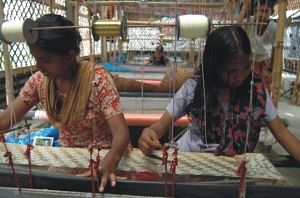Does
any one care about child workers?
Ausma
Akter Urmee
 Raju
works at a weaving factory for eight hours on average a day. At a dimly
lit damp room at Mirpur Benarasi Palli, the young boy's job is to help
the weavers with thread and sometimes he himself does the border work
on saris. At the end of a week, the boy gets only Tk. 10 as his wage.
Raju
works at a weaving factory for eight hours on average a day. At a dimly
lit damp room at Mirpur Benarasi Palli, the young boy's job is to help
the weavers with thread and sometimes he himself does the border work
on saris. At the end of a week, the boy gets only Tk. 10 as his wage.
There
is another boy like Raju working at another factory. The second boy,
Ramiz, helps his father who desperately needs his help to accelerate
his work.
There
are other boys like these two working in the area. They are ill-paid
and work in difficult conditions. Their families defend their works
saying they are too poor to keep them home or send them to school. Some
of the boys, in fact, help their weaver fathers.
Says
Ramiz's father, Sabdar Mia, "I've six children. It's quite difficult
for me to take care of them. I need help from them. If the son works,
the family benefits. Sending him to school is out of question."
But
Ramiz and Raju want to read and go to school. They really do not like
to work.
The
weaving town at Mirpur is known for making quality saris, especially
Katan and Benarasi, the wedding dress for women.
Each
factory has three types of workers: the weavers and their senior and
junior helpers. Each weaver is paid on the basis of a sari he makes
ranging from Tk. 300 to 1,200 and depending on the type of the sari.
The quicker a sari is made the bigger the income. The main artisans
feel that it is impossible to work without help such as handing the
thread and doing other errands for them. The artisans also do not consider
the work by children as abuse. They think the works the children do
are lighter and far better than that they do in tanneries or bidi factories.
Argues
Abdul Jabbar Chowdhury, a leader of the weavers' association in Mirpur,
"An adult artisan will take at least 12 days to make a good sari
without help from a boy. With help he can do it in a week."
He
admits that poverty is driving the families to send their children to
work here, even though the wages are very low. The families do not mind
the low wages because they think the children would have otherwise wasted
their time idly at home. If not working they are also not going to school.
Dr.
MA Azim Jahangir, head of Planning and Implementation Division at Bangladesh
Handloom Board, says, "In a country like Bangladesh it's difficult
to eliminate child labour. Children are required to work to help their
families. This is a cottage industry where all members of a family work."
Azim
points out that weaving a sari needs at least two hands the artisan
and someone else to help him. This helps cut the costs and improve an
artisan's skill.
Yet,
there are people who grumble against the use of young children in such
work, which deprives them of education and affects their health.
This
cottage industry employs children of various ages and according to one
study there are at least 590 children here, many of them as young as
eight while many, nearly 62 per cent, work for 13 hours a day.
The
problem relating to the child workers is complex. It is not easy to
end child labour overnight. For example, there are some schools, funded
by ILO and other organisations, for the poor children where education
is free. That does not always attract the poor children.
Whether
the children are sent to work by poor parents or they can ill-afford
education their work means violation of their rights.
The
weavers association, however, favours a middle path. Give the children
less working hours and allow them time to go to schools. Not a bad idea
isn't it?
Source:
News Network.